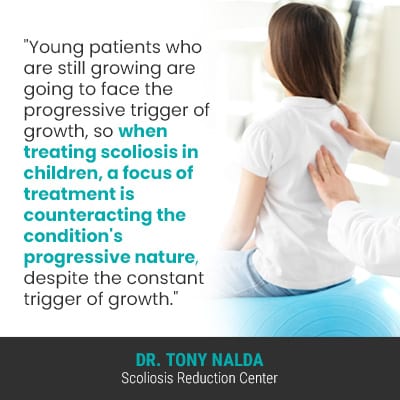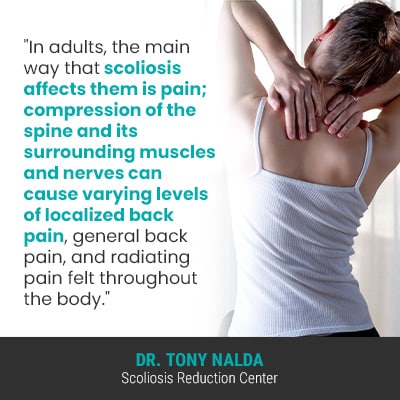Scoliosis By Age: How Scoliosis Affects Different Age Groups

Part of why the nature of scoliosis necessitates a customized treatment approach is because there are so many different types a person can develop, with wide-ranging severity levels, and different ages are affected differently by the condition, necessitating different focuses during treatment. Continue reading to learn more about how scoliosis affects different age groups.
Scoliosis is a spinal condition that affects all ages and ranges widely in severity. There are also different condition types, determined by causation. The main ways in which the scoliosis-experience differs between age groups is in symptoms and progression.
Let's first start with how scoliosis is diagnosed, and then move on to how different age groups are affected by the condition.
Table of Contents
Diagnosing Scoliosis
Scoliosis is a structural spinal condition that involves a loss of its healthy curves.
Diagnosing scoliosis is achieved through a physical examination, a scoliosis X-ray, and can involve magnetic resonance imaging.
Scoliosis involves the development of an unnatural sideways spinal curve that rotates, making it a 3-dimensional condition; in order to be considered a true scoliosis, the spine doesn't just have to bend unnaturally to the side, but also twists from front to back, back to front.
Diagnosing scoliosis also means being diagnosed with a progressive condition that has it in its nature to worsen over time, and progressive rates are one of the biggest differences between child scoliosis patients and adult scoliosis patients.
When scoliosis is first diagnosed, part of the process involves comprehensive assessment to further classify conditions based on key patient/condition variables, one of which is patient age.
Patient Age and Progression
As mentioned, one of the most important factors when it comes to predicting a patient's likeliest progressive rate is patient age.
While we don't always know what triggers scoliosis to develop, we do know what triggers it to progress: growth and development, and this is how patient age can shape a patient's progressive rate.
 Young patients who are still growing are going to face the progressive trigger of growth, so when treating scoliosis in children, a focus of treatment is counteracting the condition's progressive nature, despite the constant trigger of growth.
Young patients who are still growing are going to face the progressive trigger of growth, so when treating scoliosis in children, a focus of treatment is counteracting the condition's progressive nature, despite the constant trigger of growth.
While adults still progress, they tend to do so at a slower rate, so monitoring closely for progression isn't as much of a focus of treatment.
Patient Age and Scoliosis Symptoms
Another key difference between child and adult scoliosis is experienced symptoms; the main symptom of adult scoliosis is pain, while the main symptom of scoliosis in children is postural deviation.
Scoliosis introduces a lot of uneven forces to the body, and they can disrupt its overall symmetry in a number of ways: uneven shoulders, uneven hips, one shoulder blade protruding more than the other (uneven shoulder blades), the development of a rib arch, and changes to gait, balance, and coordination are additional symptoms.
When it comes to pain, the majority of condition-related pain is caused by compression, and scoliosis doesn't become a compressive condition until skeletal maturity has been reached, so in young patients who are still growing, the constant lengthening motion of a growing spine counteracts the compressive force of the unnatural spinal curve.
This is why scoliosis isn't commonly described as including a lot of back pain in children, but it is the number-one symptom that brings adults in to see me for a diagnosis and treatment.
With the Scoliosis Research Society putting current estimates at close to seven million people living with scoliosis in the United States alone, and scoliosis is the leading spinal condition amongst school-aged children, awareness is important.
So now that we've touched on the main differences between scoliosis in children, versus scoliosis in adults, let's break down the different age groups that classify conditions.
Congenital Scoliosis
Congenital scoliosis is diagnosed in babies who are born with the condition, and it's caused by a malformed spine that develops in utero.
This is a rare form, affecting approximately 1 in 10,000, and can involve vertebrae forming in more of a triangular shape, when healthy vertebrae are rectangular in shape, allowing the spine to stay aligned, and other causes can involve the failure of vertebral bodies to form into distinct and separate bones, instead becoming fused together.
If the spine is malformed, it's difficult for it to maintain its natural curves and alignment so an unnatural scoliotic curve develops.
Babies born with congenital scoliosis often present with other abnormalities related to malformed parts and systems within the body, so need to be examined and monitored closely.
Infantile Scoliosis
Cases of infantile scoliosis are diagnosed in infants between the ages of 6 months and 3 years old, and this type of early onset scoliosis can progress with growth, or can resolve itself, but there is no way to tell which cases will resolve on their own, and which will be triggered to progress during growth.
Infants with scoliosis have a lot of growth remaining, so this does put them at risk for significant progression and needs to be treated proactively.
Juvenile Idiopathic Scoliosis
Juvenile early onset idiopathic scoliosis is diagnosed in patients between the ages of 3 and 10 years old, and this is an age group I like to draw attention to because when diagnosed early and responded to proactively, this is the age I can make the biggest impact with.
While there are never treatment guarantees, early detection and intervention is associated with treatment success.
When scoliosis treatment is started at this age, before the first significant adolescent growth spurt, there are fewer limits to what can be achieved.
Adolescent Idiopathic Scoliosis
Adolescent idiopathic scoliosis (AIS) is the condition's most-prevalent form overall and is diagnosed in adolescents between the ages of 10 and 18.
Adolescents are at risk for rapid-phase progression because of the stage of puberty they are in, or are entering into, characterized by rapid and unpredictable growth spurts.
The main way that scoliosis affects adolescents is in postural changes, as mentioned earlier.
So a focus of treatment for adolescent idiopathic scoliosis is working towards achieving a significant curvature reduction and holding it throughout growth.
Adult Scoliosis
Adult scoliosis is diagnosed in adults who have reached skeletal maturity, and the two main forms to affect adults are idiopathic scoliosis and degenerative scoliosis.
Idiopathic scoliosis means there is no single-known cause, and 80 percent of known diagnosed cases of scoliosis are classified as idiopathic scoliosis, while the remaining 20 percent are associated with known causes: neuromuscular scoliosis, degenerative scoliosis, and congenital scoliosis.
Cases of neuromuscular scoliosis are caused by the presence of a larger neuromuscular condition such as spina bifida, muscular dystrophy, or cerebral palsy.
While adults don't face the trigger of growth, degenerative scoliosis is caused by natural age-related spinal degeneration, and once the spine's structures start to deteriorate, this can increase an adult patient's rate of curve progression.
 In adults, the main way that scoliosis affects them is pain; compression of the spine and its surrounding muscles and nerves can cause varying levels of localized back pain, general back pain, and radiating pain felt throughout the body.
In adults, the main way that scoliosis affects them is pain; compression of the spine and its surrounding muscles and nerves can cause varying levels of localized back pain, general back pain, and radiating pain felt throughout the body.
So while a significant curvature reduction is a focus in treating scoliosis in children, while I still want to reduce adult patients' curves, the focus is more on pain management and reducing scoliosis curves back to where they were before they became painful and started causing noticeable symptoms.
Conclusion
Treating scoliosis by age has different complexities that necessitate the customization of effective treatment plans.
I want to treat patients of all ages proactively because scoliosis only gets more complex to treat as it progresses, making the spine more rigid and less responsive to treatment, and giving the body time to adjust to the unnatural spinal curve's presence.
Here at the Scoliosis Reduction Center, I believe in a conservative chiropractic-centered treatment approach that integrates multiple forms of treatment so conditions can be impacted on every level.
I use condition-specific chiropractic care to work towards achieving a curvature reduction on a structural level and realigning the spine.
Through condition-specific physical therapy, I help patients increase their core strength so the spine's surrounding muscles can provide it with optimal support.
Corrective bracing can be particularly effective on growing spines, so is often a facet of treatment in child scoliosis, and in adult scoliosis, bracing is used more for short-term pain management and stabilizing the spine during treatment.
I also prescribe a series of customized exercises that patients can do from home to further stabilize and heal the spine for sustainable long-term treatment results.
Scoliosis can affect the body in a myriad of ways, and no two cases are the same, particularly as the condition ranges so widely in severity from mild to moderate and severe to very severe; regardless of age, the more severe scoliosis is, the more likely it is to cause noticeable effects.
My goals of treatment are preventing progression, achieving corrective results, and helping patients avoid the need for invasive surgical treatment in the future.
Dr. Tony Nalda
DOCTOR OF CHIROPRACTIC
After receiving an undergraduate degree in psychology and his Doctorate of Chiropractic from Life University, Dr. Nalda settled in Celebration, Florida and proceeded to build one of Central Florida’s most successful chiropractic clinics.
His experience with patients suffering from scoliosis, and the confusion and frustration they faced, led him to seek a specialty in scoliosis care. In 2006 he completed his Intensive Care Certification from CLEAR Institute, a leading scoliosis educational and certification center.
About Dr. Tony Nalda
 Ready to explore scoliosis treatment? Contact Us Now
Ready to explore scoliosis treatment? Contact Us Now





